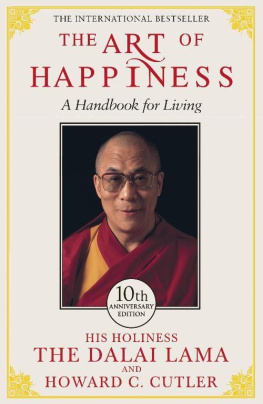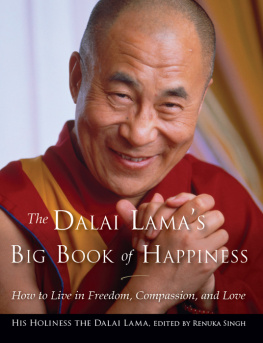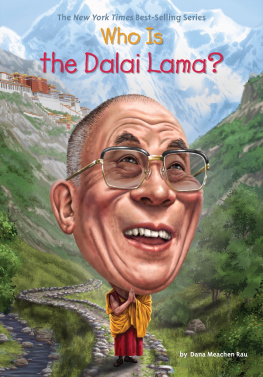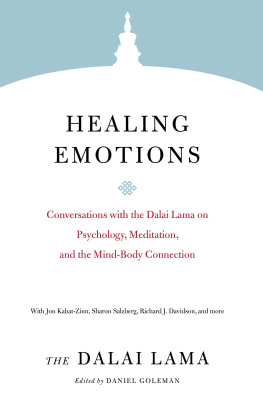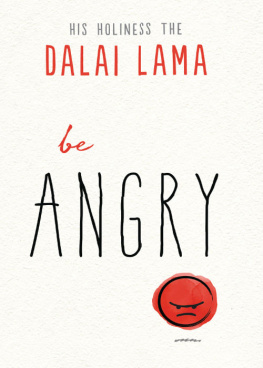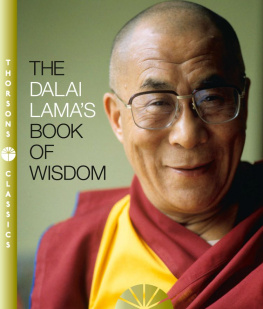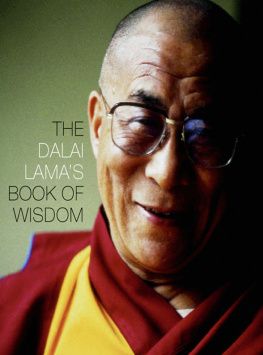Dalai Lama [Lama - The Art of Happiness
Here you can read online Dalai Lama [Lama - The Art of Happiness full text of the book (entire story) in english for free. Download pdf and epub, get meaning, cover and reviews about this ebook. year: 1999, publisher: Hodder & Stoughton, genre: Religion. Description of the work, (preface) as well as reviews are available. Best literature library LitArk.com created for fans of good reading and offers a wide selection of genres:
Romance novel
Science fiction
Adventure
Detective
Science
History
Home and family
Prose
Art
Politics
Computer
Non-fiction
Religion
Business
Children
Humor
Choose a favorite category and find really read worthwhile books. Enjoy immersion in the world of imagination, feel the emotions of the characters or learn something new for yourself, make an fascinating discovery.
- Book:The Art of Happiness
- Author:
- Publisher:Hodder & Stoughton
- Genre:
- Year:1999
- Rating:3 / 5
- Favourites:Add to favourites
- Your mark:
- 60
- 1
- 2
- 3
- 4
- 5
The Art of Happiness: summary, description and annotation
We offer to read an annotation, description, summary or preface (depends on what the author of the book "The Art of Happiness" wrote himself). If you haven't found the necessary information about the book — write in the comments, we will try to find it.
Dalai Lama [Lama: author's other books
Who wrote The Art of Happiness? Find out the surname, the name of the author of the book and a list of all author's works by series.
The Art of Happiness — read online for free the complete book (whole text) full work
Below is the text of the book, divided by pages. System saving the place of the last page read, allows you to conveniently read the book "The Art of Happiness" online for free, without having to search again every time where you left off. Put a bookmark, and you can go to the page where you finished reading at any time.
Font size:
Interval:
Bookmark:
THE ART OF HAPPINESS
A Handbook for Living
His Holiness the Dalai Lama and Howard C. Cutler, MD

www.hodder.co.uk
Copyright 1998 by HH Dalai Lama and Howard C. Cutler, MD
The right of HH Dalai Lama and Howard C. Cutler
to be identified as the Authors of the Work has
been asserted by them in accordance with the Copyright,
Designs and Patents Act 1988.
First published in 1998 by Hodder & Stoughton
A division of Hodder Headline PLC
All rights reserved. No part of this publication may be
reproduced, stored in a retrieval system, or transmitted,
in any form or by any means without the prior written permission
of the publisher, nor be otherwise circulated in any form of binding
or cover other than that in which it is published and without
a similar condition being imposed on the subsequent purchaser.
A CIP catalogue record is available from the British Library.
Epub ISBN 9781848940529
Book ISBN 9780340750155
Hodder and Stoughton
A division of Hodder Headline PLC
338 Euston Road
London NW1 3BH
www.hodder.co.uk
Dedicated to the Reader:
May you find happiness.
Contents
Authors Note
In this book, extensive conversations with the Dalai Lama have been recounted. The private meetings with the Dalai Lama in Arizona and India which form the basis of this work took place with the express purpose of collaborating on a project that would present his views on leading a happier life, augmented by my own observations and commentary from the perspective of a Western psychiatrist. The Dalai Lama generously allowed me to select whatever format for the book I felt would most effectively convey his ideas. I felt that the narrative format found in these pages would be most readable and at the same time impart a sense of how the Dalai Lama incorporates his ideas into his own daily life. With the Dalai Lamas approval, I have organized this book according to subject matter, and thus at times I have chosen to combine and integrate material that may have been taken from several different conversations. Also, with the Dalai Lamas permission, where I deemed necessary, for clarity or comprehensiveness, I have woven in material from some of his public talks in Arizona. The Dalai Lamas interpreter, Dr. Thupten Jinpa, kindly reviewed the final manuscript to assure that there were no inadvertent distortions of the Dalai Lamas ideas as a result of the editorial process.
A number of case histories and personal anecdotes have been presented to illustrate the ideas under discussion. In order to maintain confidentiality and protect personal privacy, in every instance I have changed names and altered details and other distinguishing characteristics so as to prevent identification of particular individuals.
Howard C. Cutler md
Introduction
I found the Dalai Lama alone in an empty basketball locker room moments before he was to speak before a crowd of six thousand at Arizona State University. He was calmly sipping a cup of tea, in perfect repose. Your Holiness, if youre ready...
He briskly rose, and without hesitation he left the room, emerging into the thick backstage throng of local reporters, photographers, security personnel, and students the seekers, the curious, and the skeptical. He walked through the crowd smiling broadly and greeting people as he passed by. Finally passing through a curtain, he walked on stage, bowed, folded his hands, and smiled. He was greeted with thunderous applause. At his request, the house lights were not dimmed so he could clearly see his audience, and for several moments he simply stood there, quietly surveying the audience with an unmistakable expression of warmth and goodwill. For those who had never seen the Dalai Lama before, his maroon and saffron monks robes may have created a somewhat exotic impression, yet his remarkable ability to establish rapport with his audience was quickly revealed as he sat down and began his talk.
I think that this is the first time I am meeting most of you. But to me, whether it is an old friend or new friend, theres not much difference anyway, because I always believe we are the same; we are all human beings. Of course, there may be differences in cultural background or way of life, there may be differences in our faith, or we may be of a different color, but we are human beings, consisting of the human body and the human mind. Our physical structure is the same, and our mind, and our emotional nature are also the same. Wherever I meet people, I always have the feeling that I am encountering another human being, just like myself. I find it is much easier to communicate with others on that level. If we emphasize specific characteristics, like I am Tibetan or I am Buddhist, then there are differences. But those things are secondary. If we can leave the differences aside, I think we can easily communicate, exchange ideas, and share experiences.
With this, in 1993 the Dalai Lama began a week-long series of public talks in Arizona. Plans for his visit to Arizona had been first set in motion over a decade earlier. It was at that time that we first met, while I was visiting Dharamsala, India, on a small research grant to study traditional Tibetan medicine. Dharamsala is a beautiful and tranquil village, perched on a hillside in the foothills of the Himalayas. For almost forty years, this has been the home of the Tibetan government-in-exile, ever since the Dalai Lama, along with one hundred thousand other Tibetans, fled Tibet after the brutal invasion by Chinese forces. During my stay in Dharamsala I had gotten to know several members of the Dalai Lamas family, and it was through them that my first meeting with him was arranged.
In his 1993 public address, the Dalai Lama spoke of the importance of relating as one human being to another, and it was this very same quality that had been the most striking feature of our first conversation at his home in 1982. He seemed to have an uncommon ability to put one completely at ease, to quickly create a simple and direct connection with a fellow human being. Our first meeting had lasted around forty-five minutes, and like so many other people, I came away from that meeting in great spirits, with the impression that I had just met a truly exceptional man.
As my contact with the Dalai Lama grew over the next several years, I gradually came to appreciate his many unique qualities. He has a penetrating intelligence, but without artifice; a kindness, but without excessive sentimentality; great humor, but without frivolousness; and as many have discovered, the ability to inspire rather than awe.
Over time I became convinced that the Dalai Lama had learned how to live with a sense of fulfillment and a degree of serenity that I had never seen in other people. I was determined to identify the principles that enabled him to achieve this. Although he is a Buddhist monk with a lifetime of Buddhist training and study, I began to wonder if one could identify a set of his beliefs or practices that could be utilized by non-Buddhists as well practices that could be directly applied to our lives to simply help us become happier, stronger, perhaps less afraid.
Eventually, I had an opportunity to explore his views in greater depth, meeting with him daily during his stay in Arizona and following up these discussions with more extensive conversations at his home in India. As we conversed, I soon discovered that we had some hurdles to overcome as we struggled to reconcile our different perspectives: his as a Buddhist monk, and mine as a Western psychiatrist. I began one of our first sessions, for example, by posing to him certain common human problems, illustrating them with several lengthy case histories. Having described a woman who persisted in self-destructive behaviors despite the tremendous negative impact on her life, I asked him if he had an explanation for this behavior and what advice he could offer. I was taken aback when after a long pause and reflection, he simply said, I dont know, and, shrugging his shoulders, laughed good naturedly.
Next pageFont size:
Interval:
Bookmark:
Similar books «The Art of Happiness»
Look at similar books to The Art of Happiness. We have selected literature similar in name and meaning in the hope of providing readers with more options to find new, interesting, not yet read works.
Discussion, reviews of the book The Art of Happiness and just readers' own opinions. Leave your comments, write what you think about the work, its meaning or the main characters. Specify what exactly you liked and what you didn't like, and why you think so.

